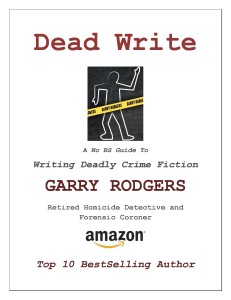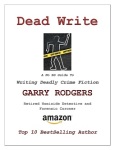To receive your FREE PDF with 95 Killer Tips On Writing Deadly Crime Fiction, enter your email address on the header or sidebar form. Read on for a sample of the first 12. All images are attributed to the TV series ‘The Simpsons’.
Writing crime fiction is like investigating murders. You deal with lies.
 Everyone lies to the police. Complainants lie. Witnesses lie. Lawyers lie. Believe it or not, even the crooks lie to the cops.
Everyone lies to the police. Complainants lie. Witnesses lie. Lawyers lie. Believe it or not, even the crooks lie to the cops.
Homicide investigators get extremely good at detecting lies. They’re human lie detectors. And they know that to get people to co-operate in investigations, there has to be something in it for them. Just like there has to be something in this for you.
 To get you to co-operate with me, I’m giving you 95 Killer Tips on how to lie to people. Because as a fiction writer, that’s what you do. You lie to your reader. Your reader signs-up for a pack of lies when she buys into your story and you owe her an excellent load of excrement in return.
To get you to co-operate with me, I’m giving you 95 Killer Tips on how to lie to people. Because as a fiction writer, that’s what you do. You lie to your reader. Your reader signs-up for a pack of lies when she buys into your story and you owe her an excellent load of excrement in return.
It’s called the suspension of disbelief. That’s what your fiction writing has to do. Your reader has to get so immersed in the story that she forgets it’s all lies. The best stories string her along so well that she can’t put it down and that’s the best compliment you, as a writer, can ever get. So you have to be really good at telling lies.
Yes, I do want something from you and I snuck it in one of the tips. You have to read them to find out what I want.
 And no, I won’t bullshit you. I used to be a cop, for God’s sakes.
And no, I won’t bullshit you. I used to be a cop, for God’s sakes.
It’s just that I wasn’t a very good one.
Here’s a sample of Dead Write – A No BS Guide To Writing Deadly Crime Fiction.
To receive your FREE PDF with 95 Killer Tips On Writing Deadly Crime Fiction, enter your email address on the header or sidebar form.
Part 1 – The Science of Story
Tip #1 – Understand Story
A story is about what happens (Plot) that affects people (Characters) who are trying to achieve a difficult goal (Conflict) and how they change as a result (Resolution).
Tip #2 – Understand Story-Telling
Story-telling is about communicating what’s happening. Humans are inherently curious creatures and, to keep your reader in the story, you have to keep her constantly wondering what’s coming next.
Tip #3 – Understand Crime Stories
 Crime Fiction involves murders. People are fascinated about murders for the same reason they can’t avoid looking at gruesome accident scenes. Like they say in the news business ‘If it bleeds, it leads.’ Being killed is the worst thing that could happen and it’s your reader’s instinct to want to know what might happen.
Crime Fiction involves murders. People are fascinated about murders for the same reason they can’t avoid looking at gruesome accident scenes. Like they say in the news business ‘If it bleeds, it leads.’ Being killed is the worst thing that could happen and it’s your reader’s instinct to want to know what might happen.
Tip #4 – Understand Cops & Crimes
Joseph Wambaugh, one of the best crime writers, says “The best stories aren’t about how cops work on cases, but about how cases work on cops.”
Tip #5 – Activate Your Reader’s Brain
Humans are hardwired for story. We think and learn in stories. We have a primal need to know in order to work our flight or fight survival instinct. Stimulating your reader’s desire to know what’s happening subconsciously fires neurons in her brain and this releases dopamine, nature’s crack, which chemically sucks her into the story. She gets immense pleasure from going along for the ride.
Tip #6 – Give Your Reader What She Needs
Stories allow your reader to simulate intense experiences without actually having to live through them. It’s like being shot at – without worrying about getting hit. Stories give vital instructions on how to survive in life, allowing your reader to become the characters without ever leaving the safety of home. She needs to feel what the people in the story feel – for her entertainment – and her protection.
Tip #7 – Balance Right & Left Brain
 Stories engage the left side of the brain to process words and sequence of plot. The right brain handles imagination and visualization. The best told stories balance the brain’s natural ability to look for, recognize, and match patterns giving your reader those critical and so-satisfying Ah-Ha! moments.
Stories engage the left side of the brain to process words and sequence of plot. The right brain handles imagination and visualization. The best told stories balance the brain’s natural ability to look for, recognize, and match patterns giving your reader those critical and so-satisfying Ah-Ha! moments.
Tip #8 – Study Neuro-Linguistics
Mind language is an amazing science that underlies story-telling. Neuro refers to what’s happening in the mind. Linguistics is how communicating through words influences the mind. It’s the art and science of communicating. The best form of getting a message across is by stimulating your reader’s senses.
Tip #9 – Apply Neuro-Linguistics
The right words, and the right sequence of words, activate your reader’s neurological system. This affects her physiology, emotions, and behavior. When she makes sense of your story, she believes in its world. She captures and conceptualizes the experience. It’s what makes her say “I couldn’t put it down.”
Tip #10 – Give Pleasure, Avoid Pain
Humans are pleasure-seeking, pain-avoiding animals. We go to extreme lengths to achieve this in life. It’s the same for your reader. She expects a pleasurable experience from your story, even when it opens with blood & guts. If she doesn’t enjoy a pleasurable state quickly into it, she’s going to put-it-down and forget about it. If it becomes painful, she’s going to slam-it-down and then go slam you on Goodreads.
Part 2 – Telling the Story
Tip #11 – Do Not Come Lightly To The Page
 Be honest. Be original. Be brutally in their face. Your job is to tell it like it is. To hell with offending anyone. Say what the story’s message is. The best stories challenge social norms.
Be honest. Be original. Be brutally in their face. Your job is to tell it like it is. To hell with offending anyone. Say what the story’s message is. The best stories challenge social norms.
Tip #12 – Write For One; Publish For A Million
To be authentic, you have to quit giving a shit what anyone thinks of your work while you write. Let it come right from the depths of your bowels as if…

